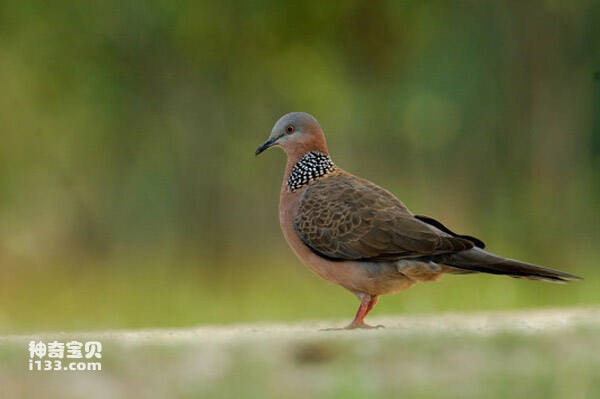Spilopelia chinensis
IUCN
LCBasic Information
Scientific classification
- name:Spilopelia chinensis
- Scientific Name:Spilopelia chinensis, Tridges, Middle spotted, floral dove, floral necked Dove, Pearl dove, spotted necked Dove, bead necked pigeon, Spilopelia chinensis,
- Outline:Landfowl
- Family:
Vital signs
- length:27-34CM
- Weight:120-205g
- lifetime:No textual research information is available
Feature
There is a large black collar on the back of the neck, which is covered with small white or yellow-white beaded spots
Distribution and Habitat
It is found in Bangladesh, Brunei Darussalam, Cambodia, China, India, Indonesia, Laos, Malaysia, Maldives, Myanmar, Philippines, Singapore, Thailand, Timor-Leste, and Vietnam, and has been introduced to Australia, Fiji, Mauritius, Mexico, New Caledonia, New Zealand, Papua New Guinea, and the United States. It is distributed in central and southern China, reaching western Sichuan and Yunnan in the west, southern Hebei and Shandong in the north, and Taiwan, Hong Kong and Hainan Island in the south.
It inhabits the plain, grassland, low hills and farmland with sparse trees, and often appears in the mixed wood forest, bamboo forest and trees near the village.
Appearance
The forehead is a pale blue-gray, gradually becoming a pale pinkish gray at the top of the head; The pillow, side of the head and neck are pink, with a large black collar on the nape of the neck, which is covered with small white or yellowish-white beaded spots, and the rest of the upper body is brown, with a lighter feather margin. The central tail feather is the same color as the back, but darker; Lateral tail feathers are black with broad white end spots. Flange, outer small and middle cover bluish-gray, the rest of the cover is lighter than the back. The feathers are dark brown with a light margin. Chin white, head side, throat, chest and abdomen pink; The two flanks, underwing coverings, axils and undertail coverings are gray.
The plumage of the female bird is similar to that of the male bird, but not as bright and less shiny.
Iris brown, deep mouth brown, feet and toes purple, claw brown.
Details
There are five subspecies of the pearl necked turtle dove (Spilopelia chinensis).

The pearl-necked turtle dove is a resident bird. They often live in small groups and sometimes mingle with other turtledoves. They often live in twos and threes on adjacent branches. The habitat is relatively fixed, if there is no interference, it can be unchanged for a long time. Most of the food on the ground, after fright immediately fly to nearby trees. The flight is fast, and the flapping of the wings is fast but not lasting. The song is loud, nodding when it purrs. It sounds like "ku-ku-u-ou", repeatedly.
It mainly feeds on plant seeds, especially crop seeds, such as rice, corn, wheat, peas, soybeans, string beans, rape, sesame, sorghum, mung beans and so on. Sometimes they also eat animal food such as maggots, snails, and insects. Usually leaves the roosting tree after dawn to forage on the ground. Used to purr for a while before leaving the habitat. Foraging activities are more active from 7:00 to 9:00 and from 15:00 to 17:00.
The breeding period of the pearl-necked turtle dove is from 3 to July. Nests are usually built on twigs or in bushes and bushes, or in crevices in rocks on the sides of mountains. The nest is flat, very simple, mainly composed of a few twigs stacked, the structure is very loose. Each clutch lays 2 eggs. Oval white, oval, smooth without spots, size 26 ~ 29 mm ×20 ~ 22 mm. The male and female incubate the eggs in turn, and the incubation period is 18 days.
The similar species Streptopelia decaocto has a black half-moon collar on the back of its neck and a broad white end spot on its tail. The difference is obvious, not hard to spot in the wild.

On August 1, 2000, the State Forestry Administration issued the List of beneficial land wildlife under State protection or of important economic and scientific research value.
Listed on the IUCN Red List of Threatened Species (IUCN 2016 ver 3.1) - Not Threatened (LC).
Protect wild animals and eliminate wild meat.
Maintaining ecological balance is everyone's responsibility!








